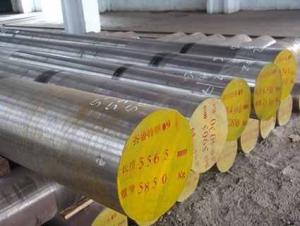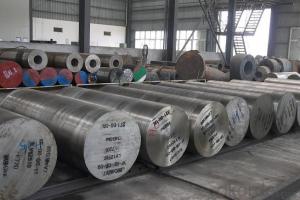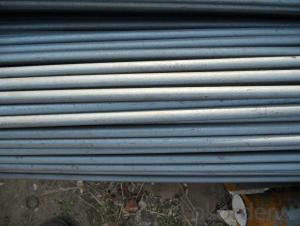45# China Standard Forged Steel Round Bar
- Loading Port:
- Shanghai
- Payment Terms:
- TT or LC
- Min Order Qty:
- 25 m.t.
- Supply Capability:
- 10000 m.t./month
OKorder Service Pledge
OKorder Financial Service
You Might Also Like
Product Description:
OKorder is offering Round Bar at great prices with worldwide shipping. Our supplier is a world-class manufacturer of steel, with our products utilized the world over. OKorder annually supplies products to European, North American and Asian markets. We provide quotations within 24 hours of receiving an inquiry and guarantee competitive prices.
Product Applications:
1) Suitable for making various strong cutting tool abrasion resistance, impact resistance.
2) Used to produce all kinds of high hard and super hard saw blade, drill, tap, broach, gear hob and various kinds of milling cutter.
3) Used for advanced punching die, screw die, and the toughness and complicated shape of the punch, etc.
Product Advantages:
OKorder's Round Bar are durable, strong, and resist corrosion.
Main Product Features:
· Premium quality
· Prompt delivery & seaworthy packing (30 days after receiving deposit)
· Corrosion resistance
· Can be recycled and reused
· Mill test certification
· Professional Service
· Competitive pricing
Product Specifications:
Diameter | Mass | Diameter | Mass | Diameter | Mass |
(mm) | (kg/m) | (mm) | (kg/m) | (mm) | (kg/m) |
6 | 0.22 | 22 | 2.98 | 53 | 17.30 |
7 | 0.30 | 24 | 3.55 | 56 | 19.30 |
8 | 0.40 | 25 | 3.85 | 60 | 22.20 |
9 | 0.50 | 26 | 4.17 | 63 | 24.50 |
10 | 0.62 | 28 | 4.83 | 65 | 26.00 |
11 | 0.75 | 30 | 5.55 | 70 | 30.20 |
12 | 0.89 | 32 | 6.31 | 75 | 34.70 |
13 | 1.04 | 34 | 7.13 | 80 | 39.50 |
14 | 1.21 | 36 | 7.99 | 85 | 44.50 |
15 | 1.39 | 38 | 8.90 | 90 | 49.90 |
16 | 1.58 | 40 | 9.86 | 95 | 55.60 |
17 | 1.78 | 42 | 10.90 | 100 | 61.70 |
18 | 2.00 | 45 | 12.50 | 120 | 88.85 |
19 | 2.23 | 48 | 14.20 | 140 | 120.93 |
20 | 2.47 | 50 | 15.40 | 150 | 138.82 |
Material: Mild Steel
Heat treatment of high quality steel:
Fire: Isothermal annealing temperature is 800 ~ 880 °C, with 10 ~ 20 °C, the furnace cooling to about 600 °C, hardness above HB269.
Preheat temperature: 730-730 °C
Quenching temperature: 1190-1210 °C
Tempering temperature: 540-595 °C
Cold drawn, hardness 285 HBS
Cold drawn after annealing condition, hardness 277 HBS
Quenching methods: oil quenching, air cooling or salt bath quenching
FAQ:
Q1: Why buy Materials & Equipment from OKorder.com?
A1: All products offered byOKorder.com are carefully selected from China's most reliable manufacturing enterprises. Through its ISO certifications, OKorder.com adheres to the highest standards and a commitment to supply chain safety and customer satisfaction.
Q2: How do we guarantee the quality of our products?
A2: We have established an advanced quality management system which conducts strict quality tests at every step, from raw materials to the final product. At the same time, we provide extensive follow-up service assurances as required.
Q3: How soon can we receive the product after purchase?
A3: Within three days of placing an order, we will begin production. The specific shipping date is dependent upon international and government factors, but is typically 7 to 10 workdays.
Images:


- Q: How do you cut steel round bars?
- To cut steel round bars, there are several methods that can be used depending on the specific requirements and available tools. Here are a few common techniques: 1. Abrasive Cutting: This method involves using an abrasive cutting wheel or disc, usually mounted on a handheld angle grinder or a chop saw. The round bar is secured in place, and the cutting wheel is applied to create a groove on the bar's surface. By applying pressure and rotating the bar, the cutting wheel gradually cuts through the steel. 2. Cold Saw: A cold saw is a specialized machine used for cutting metal. It has a circular blade that operates at a low speed, reducing heat generation during the cutting process. The round bar is securely clamped in place, and the cold saw's blade is lowered onto the bar, cutting through it with precision. 3. Band Saw: A band saw is another machine commonly used to cut steel round bars. It consists of a continuous toothed metal band that rotates on two pulleys. The round bar is secured in a vise, and the band saw is adjusted to the desired cutting angle and speed. The bar is then fed into the blade, which cuts through it smoothly. 4. Torch Cutting: For thicker steel round bars, oxy-fuel torch cutting can be employed. This method involves using a torch that combines oxygen and fuel gas, such as acetylene, to generate a high-temperature flame. The round bar is heated until it reaches a molten state, and then a separate stream of oxygen is directed onto the heated region, causing the steel to oxidize rapidly and form a cut. Regardless of the method used, it is crucial to take proper safety precautions, such as wearing protective goggles, gloves, and ensuring a stable work surface. Additionally, using the appropriate cutting tools and techniques for the specific type of steel being cut is essential to achieve clean and precise cuts.
- Q: What is the cost of steel round bars compared to other materials?
- The cost of steel round bars can vary depending on various factors such as the grade of steel, the size and dimensions of the bar, and market conditions. However, in general, steel round bars tend to be more cost-effective compared to other materials commonly used in construction and manufacturing. For instance, when compared to materials like aluminum or titanium, steel round bars are typically more affordable. Steel is abundantly available, making it a cost-efficient choice for many applications. Additionally, steel has excellent strength and durability properties, making it a preferred material for structural purposes. Compared to materials like wood or plastic, steel round bars may be more expensive initially. However, when considering the long-term benefits such as its longevity, resistance to corrosion, and minimal maintenance requirements, steel still offers a cost-effective solution. It is important to note that the cost of steel round bars can vary significantly depending on market conditions, such as the availability of raw materials and the demand for steel products. Additionally, specialized or high-grade steel alloys may come at a higher cost due to their specific properties or manufacturing processes. In summary, steel round bars generally offer a cost-effective option compared to many other materials used in construction and manufacturing. However, it is always recommended to research current market prices and consider specific project requirements before making any final cost assessments.
- Q: How about tempering No. 45 round bar?
- Quenched and tempered steel has two major categories: carbon quenched and tempered steel and alloy quenched and tempered steel. Carbon steel or alloy steel, the control of carbon content is relatively strict. If the carbon content is too high, after quenching and tempering the strength of the workpiece is high, but the toughness is not enough, such as carbon content is too low, toughness and lack of strength. In order to make the quenched and tempered parts get good comprehensive performance, the total carbon content is controlled at 0.30~0.50%.
- Q: What are the different grades of alloy steel round bars for automotive applications?
- Automotive applications commonly utilize alloy steel round bars due to their exceptional strength, durability, and resistance to wear and corrosion. The grading of these bars is typically based on their chemical composition, mechanical properties, and appropriateness for specific automotive uses. Here are several distinct grades of alloy steel round bars frequently employed in automotive applications: 1. 4140/42CrMo4: Renowned for its high tensile strength, good toughness, and excellent fatigue strength, this grade of alloy steel round bars is extensively employed in gears, crankshafts, axles, and suspension components. 2. 8620: Offering exceptional hardenability, this grade of alloy steel round bars can be subjected to heat treatment to attain high strength and toughness. It is commonly utilized in shafts, gears, and camshafts. 3. 4340: Known for its impressive strength and toughness, this grade of alloy steel round bars provides good wear resistance and can be heat treated to achieve even greater hardness and strength. It is often used in connecting rods, crankshafts, and high-stress components. 4. 52100: This high carbon, chromium alloy steel is renowned for its outstanding hardness and wear resistance. It is commonly employed in applications such as bearings and races that require high strength and durability. 5. 316L: Recognized for its exceptional corrosion resistance, particularly in harsh environments, this grade of alloy steel round bars is frequently utilized in automotive applications like exhaust systems, where resistance to corrosion is crucial. 6. 4340M: Specifically designed for high-performance automotive applications, this modified version of the 4340 grade offers improved fatigue strength and toughness. It is suitable for demanding applications, including high-performance engine components. These examples represent only a few of the various grades of alloy steel round bars employed in automotive applications. The selection of a specific grade depends on the requirements of the application, including desired strength, toughness, wear resistance, and corrosion resistance.
- Q: Can steel round bars be used for making power transmission systems?
- Certainly! Power transmission systems can indeed be made using steel round bars. Various industries commonly use steel round bars because of their remarkable strength and durability. Their capacity to endure high torque and load capacities makes them suitable for power transmission systems. Steel round bars can be machined and shaped into different sizes and forms, offering versatility for diverse power transmission applications. Moreover, steel exhibits exceptional wear resistance and can withstand severe operating conditions, rendering it an ideal material for power transmission systems that necessitate enduring performance.
- Q: What are the different surface finishes available for steel round bars?
- There are several surface finishes available for steel round bars, each offering unique properties and applications. Some of the common surface finishes include: 1. Hot Rolled: This is the most basic surface finish, achieved by heating the steel above its recrystallization temperature and then allowing it to cool. It provides a rough and scaled surface, ideal for applications that do not require a high level of aesthetics. 2. Cold Drawn: In this process, the steel round bar is pulled through a die at room temperature, resulting in a smooth and polished surface. Cold drawn surface finish offers improved dimensional accuracy and tighter tolerances, making it suitable for applications that require precision and a visually appealing appearance. 3. Turned and Polished: Steel round bars can be turned on a lathe machine to achieve a smooth and shiny surface finish. This process removes any imperfections and irregularities, providing a close tolerance and highly finished surface. Turned and polished bars are often used in applications where a high level of surface finish and dimensional accuracy is required, such as in the manufacturing of shafts and precision components. 4. Ground: Steel round bars can be ground to remove any surface defects or irregularities. Grinding produces a highly accurate and smooth surface finish, making it suitable for applications that require close tolerances and a superior surface finish. Ground bars are commonly used in the manufacturing of bearings, gears, and other high-precision components. 5. Coated: Steel round bars can also be coated with various materials to enhance their performance and protect them from corrosion. Common coating options include zinc, chrome, and nickel. Coated bars offer improved durability, resistance to corrosion, and enhanced aesthetic appeal. The choice of surface finish for steel round bars depends on the specific requirements of the application, such as dimensional accuracy, surface quality, corrosion resistance, and aesthetic appeal.
- Q: What are the different packaging options for steel round bars?
- The different packaging options for steel round bars usually include bundles, wooden crates, or steel frames.
- Q: Can steel round bars be used for making musical instruments?
- Yes, steel round bars can be used for making musical instruments. They can be used to create various percussion instruments such as steel drums or xylophones. The steel round bars can be tuned to produce specific musical notes and can be shaped and crafted to achieve the desired sound.
- Q: What is the maximum nitrogen content allowed for steel round bars?
- The maximum nitrogen content allowed for steel round bars varies depending on the specific steel grade and application requirements. However, in general, the nitrogen content is typically limited to around 0.025-0.035% to maintain the desired mechanical properties and avoid detrimental effects on the material's performance.
- Q: Can steel round bars be used for decorative purposes?
- Indeed, decorative purposes can be served by steel round bars. When utilized in diverse architectural and interior design ventures, they contribute a contemporary and industrial appeal. By shaping, bending, and welding steel round bars, one can fashion exclusive and attention-grabbing items like furniture, sculptures, railings, and decorative accents. Their polished and metallic look harmonizes with various styles and design motifs, rendering them a versatile option for embellishment. Moreover, the durability and longevity of steel round bars guarantee that these decorative elements will endure the passage of time.
Send your message to us
45# China Standard Forged Steel Round Bar
- Loading Port:
- Shanghai
- Payment Terms:
- TT or LC
- Min Order Qty:
- 25 m.t.
- Supply Capability:
- 10000 m.t./month
OKorder Service Pledge
OKorder Financial Service
Similar products
Hot products
Hot Searches
Related keywords




























